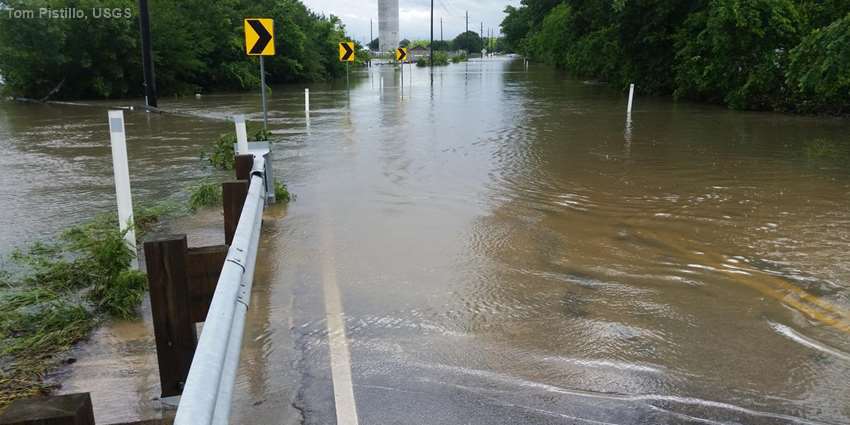Texas cities are expanding fast. Between 2010 and 2019, six of the 15 fastest-growing cities in the United States were in Texas. Bigger cities mean less land to soak up rainwater, leading to increased flood risk. Add climate change to the equation, and you have a bigger flooding problem to solve.
Buildings, roads, sidewalks and other city elements are impervious: they can’t soak up water like soil can. Instead, water runs off the impervious surfaces, flowing into neighboring streams and low-lying areas. Having faster and higher amounts of runoff results in more flooding, said Wonmin Sohn, Ph.D. She is an assistant professor in Michigan State University’s School of Planning, Design and Construction.
“Wetlands and forests absorb water through their soils and vegetation and store those flood waters. The conversion to impervious surfaces limits the capacity of soils to hold water, reducing resilience to flooding,” Sohn said. She recently published two studies about land use changes and flooding in Texas, one of which was funded by Texas Water Resources Institute’s Mills Scholars Program.
Changes to land use affect flooding because they change the landscape’s hydrology, said Fouad Jaber, Ph.D., Texas A&M University associate professor and Extension specialist at the Texas A&M AgriLife Research and Extension Center at Dallas. Jaber was a coauthor of one of Sohn’s recent studies.
“There’s the normal, natural hydrology, and it varies based on location,” Jaber said. “If you’re in a desert with very sandy soils, the normal thing is never to see any runoff. Everything infiltrates. But for us to live, we change it, right? And whenever you change anything, you're going to change hydrology, and changing hydrology can result in total ecological changes. Whatever changes the hydrology will result in worsening runoff and flooding.”
That flooding can follow not only large, devastating rain events like Hurricane Harvey and the 2016 Tax Day Flood, but also smaller, more frequent storms.
“Capturing and storing floodwater from both frequent and infrequent storms are thus of utmost importance for offsetting the land use conversion effects in a city,” Sohn said.
A changing equation
The problem, Jaber said, is that past flood preparations haven’t aged well. Flood mitigation is an equation, and the variables have changed over time.
Stormwater systems are built based on how much flooding is expected to happen. The amount of flooding depends on how much water the soil can absorb, as well as the number and size of rain events.
Jaber gave the example of a city with enough green space to absorb two inches of water.
“Every time we get a two-inch storm, which is like the one-year storm that happens once a year, the majority of the water is absorbed,” he said.
“Then when you get the 10-year storm, when you get five inches of water, two inches gets absorbed, and then three inches becomes runoff and overflows. So that’s what you design stormwater systems for — you’re designing for those three inches that are not going to be absorbed.”
But as cities expand and more impervious surfaces replace green spaces, less water can be absorbed, changing the equation.
“Any impervious design that happens after a stormwater network is already installed is changing what they designed that network for. And therefore, the network can be overwhelmed by smaller storms,” he said.
Jaber and Sohn added that the equations also didn’t account for flood-causing storms becoming more common as a result of climate change.
“Climate change is ongoing. The frequency and intensity of the heavy flood events will increase. And increasing ocean temperature will fuel larger, higher categories of hurricanes from the Gulf of Mexico,” Sohn said.
In one of her recent studies, Sohn stated that “the capacity of the environment to recover from urbanization has become even more limited as a result of climate change.” Jaber, who was not a part of that study, agreed.
“Even if no change happened in the land use, but we’re getting more rain, the basic calculation is wrong,” Jaber said. “What we have is a combination, really. We have old stormwater infrastructure that's very expensive to replace, and we have change in land use, which is resulting in higher flows from the current storms, and we are expecting maybe a 50% increase in some storms by 2045.”
Adding up the solutions
One way to adjust the equation is through structural change, Jaber said. Green infrastructure, which mimics natural processes, can soak up more water. Larger scale changes such restoring wetlands, creating large retention basins and revamping stormwater systems can also store and redirect water.
“I strongly recommend that cities not only increase pipe sizes and create fancy stormwater networks, but also add as much green space and green infrastructure, meaning rain gardens, bioretention and rainwater harvesting, as possible, because the combination is good,” Jaber said. “Then you can design for the climate changes 100 years from now, and that’s what increases your resiliency.”
But Sohn and Jaber said that structural solutions alone won’t be enough.
“To achieve long term resilience, nonstructural approaches should supplement these structural approaches,” Sohn said. “Nonstructural measures depend on policy intervention.”
Nonstructural measures like zoning regulations can help ensure fewer houses are built in flood plains, while tax breaks can help incentivize rainwater harvesting. Expanding flood education and outreach can also help mitigate risks.
Sohn and Jaber said that any solutions should therefore work on multiple scales — in terms of size, time and cost.
Jaber laid out one way for cities to ramp up flood solutions, starting with more affordable green infrastructure solutions.
“If you don't have a lot of money, put one rain garden, and next year in the budget, put another one, and another. There’s going to be a limit, eventually. Every corner where we could put a rain garden, we did. Every house put in a 1000-gallon rainwater harvesting tank. And we captured three more inches of water,” Jaber said.
“Then climate change says it’s five inches, so you have these two inches that are going to be still flooding. That's when you can do a capital project and change your storm water network. But you only have to account for those two more inches. And you hope that in the parallel the whole world is working on fixing climate change.”
Multiscale solutions are in progress in cities across Texas.
In Austin, residents can get a rebate for doing rainwater harvesting, which helps minimize runoff. Thanks to green infrastructure, Houston’s Bagby Street has weathered several major floods — including Hurricane Harvey — without flooding. The success of green infrastructure in Dallas’ Deep Ellum neighborhood is inspiring new citywide flood mitigation projects.
Jaber and Sohn hope that land development projects continue incorporating more multiscale flood solutions. After all, urbanization and climate change aren’t going away anytime soon.
“Going forward, people need to think about land use conversion. If you have land that you're building a house on, there are ways to make it such that it's a low impact development,” Jaber said. “There's no excuse for that not being the norm of going forward. Because why create more problems, when the solutions are there?”


